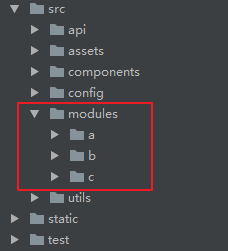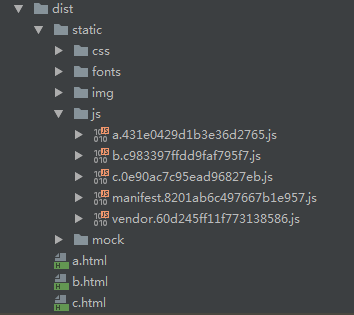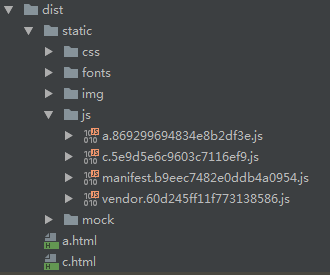github地址
https://github.com/shuidian/v...
为了充分发扬拿来主义的原则,先放出github地址,clone下来即可测试运行效果。如果觉得还可以的话,请点star,为更多人提供方便。
背景
在实际的开发过程中,单页应用并不能满足所有的场景。传统单页应用所生成的成果物,在单个系统功能拆分和多个系统灵活组装时并不方便。举个例子,我们在A系统中开发了一个实时视频预览模块和一个gis模块,传统方式打包A系统,我们会生成一个静态资源包,这个包,包含了实时视频预览模块和gis模块在内的所有模块。那么,现在有一个新的系统要做,碰巧需要原来A系统中的gis模块,那么我们只能把A系统打包,然后拿过来,通过引入url的方式,只使用其中的一个模块。这样做的问题很明显,我只需要A系统中的一个模块,但是我要引入整个A系统的资源包,这显然不合理。那么我们的需求就是从这里产生的,如果我们在开发系统A时,能够按模块划分生成多份静态资源包,最终的成果物中,会有多个子目录,每个子目录可独立运行,完成一个业务功能。这样的话,我们有任何系统需要我们开发过的任何模块,都可以直接打包指定的模块,灵活组装。
场景分析
首先,这种方案不是完全适合任何场景的,在使用时,还需要注意鉴别是否适用于当前业务场景。下面分析一下这种方式的优缺点:
优点:
1、可与其他系统灵活组装
2、各个模块相互不受影响,所以不受框架和开发模式的制约
3、不同模块可以分开部署
4、后期维护风险小,可以持续的、稳定的进行维护(万一哪天vue/react/angular被淘汰了,不会受太大影响,每个模块分别迭代就好)
缺点:
1、各个模块有相互独立的资源包,那么如果有相同的资源引用,不能复用
2、模块的组装要依赖iframe,所以要对浏览器安全设置、cookie共享等问题进行单独处理
3、用iframe来包裹组件,组件所能控制到的范围就是其所在的iframe,当涉及到全屏的应用场景时,会比较麻烦
4、不同组件之间的通信比较麻烦
以上只是分析应用场景,下面重点讲解一下如何实现多模块独立打包。
我们的目标
vue-cli默认打包方式的成果物与我们修改后生成的成果物结构对比如下:
上图为默认配置下,打包成果物的目录结构,下图为我们修改配置后,打包成果物的目录结构
思路分析
我们最终输出的成果物是多个独立的目录,那么我们就应该区分这些模块,最好的方式就是每个模块的代码放在不同的目录中,所以我们需要在src中创建每个模块的目录。暂时我们以a,b,c三个模块为例,由于我们现在的项目是多模块的,每个模块都应该有独立的入口,所以我们修改src目录结构如下:
其他目录你怎么命名,以及要不要都无所谓,主要是modules目录,我们会在下面创建若干个模块。原来的src下的main.js、index.html和app.vue已经没用了,可以删掉了。然后模块内的目录结构如下图所示:
聪明的同学已经看出来了,这里其实就是跟原来的src下的main.js、index.html和app.vue一样的,只不过我们把main.js改成了index.js而已。那么如果模块内要使用路由、状态管理都可以根据自己的需求去配置了,如何配置就不在这里讨论了。
那么如何从这些模块开始,把项目最终编译成三个独立的静态资源包呢?简单来说,其实就是循环跑三次打包脚本,每次打包一个模块,然后修改一下文件输出路径,把编译好的文件输出到dist目录下的a,b,c目录中。这样最基本的模块分开打包功能就完成了,但是还有以下一些问题需要处理。
1、这样打出的包,各个模块彼此独立。如果有这些模块是在一个系统中使用的,那么应该把多个模块重复的东西抽取出来复用。
2、如果只需要系统中的部分模块,那么应该只打包需要的模块,并且把需要打包的模块之间的重复代码抽取出来复用。
问题解决方案
针对第一个问题:实质上只要把webpack配置成多入口的方式即可,这样在编译时webpack可以把模块之间的重复代码抽取出来,最终的成果物就是一个静态资源包加多个html文件。这种方式的成果物目录结构如下:
针对第二个问题:其实跟第一个问题一样,只不过把webpack的入口配置成可变的就可以了,需要打包哪些模块,就把入口设置为哪些模块即可。这种方式的成果物目录如下(假设要打包a,c两个模块):
修改webpack配置的详细步骤
第一步:增加build/module-conf.js用来处理获取模块目录等问题
var chalk = require('chalk')
var glob = require('glob')
// 获取所有的moduleList
var moduleList = []
var moduleSrcArray = glob.sync('./src/modules/*')
for(var x in moduleSrcArray){
moduleList.push(moduleSrcArray[x].split('/')[3])
}
// 检测是否在输入的参数是否在允许的list中
var checkModule = function () {
var module = process.env.MODULE_ENV
// 检查moduleList是否有重复
var hash = {}
var repeatList = []
for(var l = 0;l < moduleList.length; l++){
if(hash[moduleList[l]]){
repeatList.push(moduleList[l])
}
hash[moduleList[l]] = true
}
if(repeatList.length > 0){
console.log(chalk.red('moduleList 有重复:'))
console.log(chalk.red(repeatList.toString()))
return false
}
let result = true
let illegalParam = ''
for (let moduleToBuild of module.split(',')) {
if (moduleList.indexOf(moduleToBuild) === -1) {
result = false
illegalParam = moduleToBuild
break
}
}
if(result === false){
console.log(chalk.red('参数错误,允许的参数为:'))
console.log(chalk.green(moduleList.toString()))
console.log(chalk.yellow(`非法参数:${illegalParam}`))
}
return result
}
// 获取当前要打包的模块列表
function getModuleToBuild () {
let moduleToBuild = []
if (process.env.NODE_ENV === 'production') {
/* 部署态,构建要打包的模块列表,如果指定了要打包的模块,那么按照指定的模块配置入口
* 这里有个特性,即使参数未传,那么获取到的undefined也是字符串类型的,不是undefined类型
* */
if (process.env.MODULE_ENV !== 'undefined') {
moduleToBuild = process.env.MODULE_ENV.split(',')
} else {
// 如果未指定要打包的模块,那么打包所有模块
moduleToBuild = moduleList
}
} else {
// 开发态,获取所有的模块列表
moduleToBuild = moduleList
}
return moduleToBuild
}
exports.moduleList = moduleList
exports.checkModule = checkModule
exports.getModuleToBuild = getModuleToBuild
第二步:增加build/build-all.js用来处理循环执行打包命令
const path = require('path')
const execFileSync = require('child_process').execFileSync;
const moduleList = require('./module-conf').moduleList || []
const buildFile = path.join(__dirname, 'build.js')
for( const module of moduleList){
console.log('正在编译:',module)
// 异步执行构建文件,并传入两个参数,module:当前打包模块,separate:当前打包模式(分开打包)
execFileSync( 'node', [buildFile, module, 'separate'], {})
}第三步:修改build/build.js增加MODULE_ENV参数,用来记录当前打包的模块名称,增加MODE_ENV参数,用来记录当前打包的模式
'use strict'
require('./check-versions')()
const chalk = require('chalk')
process.env.NODE_ENV = 'production'
// MODULE_ENV用来记录当前打包的模块名称
process.env.MODULE_ENV = process.argv[2]
// MODE_ENV用来记录当前打包的模式,total代表整体打包(静态资源在同一个目录下,可以复用重复的文件),separate代表分开打包(静态资源按模块名称分别独立打包,不能复用重复的文件)
process.env.MODE_ENV = process.argv[3]
// 如果有传参时,对传入的参数进行检测,如果参数非法,那么停止打包操作
const checkModule = require('./module-conf').checkModule
if (process.env.MODULE_ENV !== 'undefined' && !checkModule()) {
return
}
const path = require('path')
const ora = require('ora')
const rm = require('rimraf')
const webpack = require('webpack')
const config = require('../config')
const webpackConfig = require('./webpack.prod.conf')
const spinner = ora('building for production...')
spinner.start()
rm(path.join(config.build.assetsRoot, config.build.assetsSubDirectory), err => {
if (err) throw err
webpack(webpackConfig, (err, stats) => {
spinner.stop()
if (err) throw err
process.stdout.write(stats.toString({
colors: true,
modules: false,
children: false, // If you are using ts-loader, setting this to true will make TypeScript errors show up during build.
chunks: false,
chunkModules: false
}) + '\n\n')
if (stats.hasErrors()) {
console.log(chalk.red(' Build failed with errors.\n'))
process.exit(1)
}
console.log(chalk.cyan(' Build complete.\n'))
console.log(chalk.yellow(
' Tip: built files are meant to be served over an HTTP server.\n' +
' Opening index.html over file:// won\'t work.\n'
))
})
})
第四步:修改config/index.js的配置,修改打包时的出口目录配置、html入口模板的配置以及静态资源路径配置
'use strict'
// Template version: 1.3.1
// see http://vuejs-templates.github.io/webpack for documentation.
const path = require('path')
const MODULE = process.env.MODULE_ENV || 'undefined'
// 入口模板路径
const htmlTemplate = `./src/modules/${MODULE}/index.html`
module.exports = {
dev: {
// Paths
assetsSubDirectory: 'static',
assetsPublicPath: '/',
proxyTable: {},
// Various Dev Server settings
host: 'localhost', // can be overwritten by process.env.HOST
port: 8086, // can be overwritten by process.env.PORT, if port is in use, a free one will be determined
autoOpenBrowser: false,
errorOverlay: true,
notifyOnErrors: true,
poll: false, // https://webpack.js.org/configuration/dev-server/#devserver-watchoptions-
// Use Eslint Loader?
// If true, your code will be linted during bundling and
// linting errors and warnings will be shown in the console.
useEslint: true,
// If true, eslint errors and warnings will also be shown in the error overlay
// in the browser.
showEslintErrorsInOverlay: false,
/**
* Source Maps
*/
// https://webpack.js.org/configuration/devtool/#development
devtool: 'cheap-module-eval-source-map',
// If you have problems debugging vue-files in devtools,
// set this to false - it *may* help
// https://vue-loader.vuejs.org/en/options.html#cachebusting
cacheBusting: true,
cssSourceMap: true
},
build: {
// Template for index.html
index: path.resolve(__dirname, '../dist', MODULE, 'index.html'),
// 加入html入口
htmlTemplate: htmlTemplate,
// Paths
// assetsRoot: path.resolve(__dirname, '../dist', MODULE),
// 这里判断一下打包的模式,如果是分开打包,要把成果物放到以模块命名的文件夹中
assetsRoot: process.env.MODE_ENV === 'separate' ? path.resolve(__dirname, '../dist', MODULE) : path.resolve(__dirname, '../dist'),
assetsSubDirectory: 'static',
// 这里的路径改成相对路径,原来是assetsPublicPath: '/',
// assetsPublicPath: '/',
assetsPublicPath: '',
/**
* Source Maps
*/
productionSourceMap: true,
// https://webpack.js.org/configuration/devtool/#production
devtool: '#source-map',
// Gzip off by default as many popular static hosts such as
// Surge or Netlify already gzip all static assets for you.
// Before setting to `true`, make sure to:
// npm install --save-dev compression-webpack-plugin
productionGzip: false,
productionGzipExtensions: ['js', 'css'],
// Run the build command with an extra argument to
// View the bundle analyzer report after build finishes:
// `npm run build --report`
// Set to `true` or `false` to always turn it on or off
bundleAnalyzerReport: process.env.npm_config_report
}
}第五步:修改webpack.base.conf.js的入口配置,根据传参,动态配置入口文件
entry() {
// 初始化入口配置
const entry = {}
// 所有模块的列表
const moduleToBuild = require('./module-conf').getModuleToBuild() || []
// 根据传入的待打包目录名称,构建多入口配置
for (let module of moduleToBuild) {
entry[module] = `./src/modules/${module}/index.js`
}
return entry
},第六步:修改webpack.dev.conf.js的配置,增加多入口时webpackHtmlPlugin插件的配置,增加静态资源服务器的配置
'use strict'
const utils = require('./utils')
const webpack = require('webpack')
const config = require('../config')
const merge = require('webpack-merge')
const path = require('path')
const baseWebpackConfig = require('./webpack.base.conf')
const CopyWebpackPlugin = require('copy-webpack-plugin')
const HtmlWebpackPlugin = require('html-webpack-plugin')
const FriendlyErrorsPlugin = require('friendly-errors-webpack-plugin')
const portfinder = require('portfinder')
const HOST = process.env.HOST
const PORT = process.env.PORT && Number(process.env.PORT)
const moduleList = require('./module-conf').moduleList || []
// 组装多个(有几个module就有几个htmlWebpackPlugin)htmlWebpackPlugin,然后追加到配置中
const htmlWebpackPlugins = []
for (let module of moduleList) {
htmlWebpackPlugins.push(new HtmlWebpackPlugin({
filename: `${module}/index.html`,
template: `./src/modules/${module}/index.html`,
inject: true,
chunks: [module]
}))
}
const devWebpackConfig = merge(baseWebpackConfig, {
module: {
rules: utils.styleLoaders({ sourceMap: config.dev.cssSourceMap, usePostCSS: true })
},
// cheap-module-eval-source-map is faster for development
devtool: config.dev.devtool,
// these devServer options should be customized in /config/index.js
devServer: {
clientLogLevel: 'warning',
historyApiFallback: {
rewrites: [
{ from: /.*/, to: path.posix.join(config.dev.assetsPublicPath, 'index.html') },
],
},
hot: true,
contentBase: false, // since we use CopyWebpackPlugin.
compress: true,
host: HOST || config.dev.host,
port: PORT || config.dev.port,
open: config.dev.autoOpenBrowser,
overlay: config.dev.errorOverlay
? { warnings: false, errors: true }
: false,
publicPath: config.dev.assetsPublicPath,
proxy: config.dev.proxyTable,
quiet: true, // necessary for FriendlyErrorsPlugin
watchOptions: {
poll: config.dev.poll,
},
setup(app) {
// 写个小路由,打开浏览器的时候可以选一个开发路径
let html = `调试页面 `
html += ``
html += ``
html += ``
html += ``
// let sentHref = ''
// for(var module in moduleList){
// sentHref += '点我调试模块:'+ moduleList[module].toString() +'
'
// }
app.get('/moduleList', (req, res, next) => {
res.send(html)
})
// 访问根路径时重定向到moduleList
app.get('/', (req, res, next) => {
res.redirect('/moduleList')
})
}
},
plugins: [
new webpack.DefinePlugin({
'process.env': require('../config/dev.env')
}),
new webpack.HotModuleReplacementPlugin(),
new webpack.NamedModulesPlugin(), // HMR shows correct file names in console on update.
new webpack.NoEmitOnErrorsPlugin(),
// copy custom static assets
new CopyWebpackPlugin([
{
from: path.resolve(__dirname, '../static'),
to: config.dev.assetsSubDirectory,
ignore: ['.*']
}
]),
// https://github.com/ampedandwired/html-webpack-plugin
// new HtmlWebpackPlugin({
// filename: 'a/index.html',
// template: './src/modules/a/index.html',
// inject: true,
// chunks: ['a']
// }),
].concat(htmlWebpackPlugins)
})
module.exports = new Promise((resolve, reject) => {
portfinder.basePort = process.env.PORT || config.dev.port
portfinder.getPort((err, port) => {
if (err) {
reject(err)
} else {
// publish the new Port, necessary for e2e tests
process.env.PORT = port
// add port to devServer config
devWebpackConfig.devServer.port = port
// Add FriendlyErrorsPlugin
devWebpackConfig.plugins.push(new FriendlyErrorsPlugin({
compilationSuccessInfo: {
messages: [`Your application is running here: http://${devWebpackConfig.devServer.host}:${port}`],
},
onErrors: config.dev.notifyOnErrors
? utils.createNotifierCallback()
: undefined
}))
resolve(devWebpackConfig)
}
})
})
第七步:修改webpack.prod.conf.js的配置,增加对不同打包模式的处理。
'use strict'
const path = require('path')
const utils = require('./utils')
const webpack = require('webpack')
const config = require('../config')
const merge = require('webpack-merge')
const baseWebpackConfig = require('./webpack.base.conf')
const CopyWebpackPlugin = require('copy-webpack-plugin')
const HtmlWebpackPlugin = require('html-webpack-plugin')
const ExtractTextPlugin = require('extract-text-webpack-plugin')
const OptimizeCSSPlugin = require('optimize-css-assets-webpack-plugin')
const UglifyJsPlugin = require('uglifyjs-webpack-plugin')
const env = process.env.NODE_ENV === 'testing'
? require('../config/test.env')
: require('../config/prod.env')
// 获取所有模块列表
const moduleToBuild = require('./module-conf').getModuleToBuild() || []
// 组装多个(有几个module就有几个htmlWebpackPlugin)htmlWebpackPlugin,然后追加到配置中
const htmlWebpackPlugins = []
// 判断一下是否为分开打包模式
if (process.env.MODE_ENV === 'separate') {
// 分开打包时是通过重复运行指定模块打包命令实现的,所以每次都是单个html文件,只要配置一个htmlPlugin
htmlWebpackPlugins.push(new HtmlWebpackPlugin({
filename: process.env.NODE_ENV === 'testing'
? 'index.html'
: config.build.index,
// template: 'index.html',
template: config.build.htmlTemplate,
inject: true,
minify: {
removeComments: true,
collapseWhitespace: true,
removeAttributeQuotes: true
// more options:
// https://github.com/kangax/html-minifier#options-quick-reference
},
// necessary to consistently work with multiple chunks via CommonsChunkPlugin
chunksSortMode: 'dependency'
}))
} else {
// 一起打包时是通过多入口实现的,所以要配置多个htmlPlugin
for (let module of moduleToBuild) {
htmlWebpackPlugins.push(new HtmlWebpackPlugin({
filename: `${module}.html`,
template: `./src/modules/${module}/index.html`,
inject: true,
// 这里要指定把哪些chunks追加到html中,默认会把所有入口的chunks追加到html中,这样是不行的
chunks: ['vendor', 'manifest', module],
// filename: process.env.NODE_ENV === 'testing'
// ? 'index.html'
// : config.build.index,
// template: 'index.html',
minify: {
removeComments: true,
collapseWhitespace: true,
removeAttributeQuotes: true
// more options:
// https://github.com/kangax/html-minifier#options-quick-reference
},
// necessary to consistently work with multiple chunks via CommonsChunkPlugin
chunksSortMode: 'dependency'
}))
}
}
// 获取当前打包的目录名称
const webpackConfig = merge(baseWebpackConfig, {
module: {
rules: utils.styleLoaders({
sourceMap: config.build.productionSourceMap,
extract: true,
usePostCSS: true
})
},
devtool: config.build.productionSourceMap ? config.build.devtool : false,
output: {
path: config.build.assetsRoot,
filename: utils.assetsPath('js/[name].[chunkhash].js'),
chunkFilename: utils.assetsPath('js/[id].[chunkhash].js')
},
plugins: [
// http://vuejs.github.io/vue-loader/en/workflow/production.html
new webpack.DefinePlugin({
'process.env': env
}),
new UglifyJsPlugin({
uglifyOptions: {
compress: {
warnings: false
}
},
sourceMap: config.build.productionSourceMap,
parallel: true
}),
// extract css into its own file
new ExtractTextPlugin({
filename: utils.assetsPath('css/[name].[contenthash].css'),
// Setting the following option to `false` will not extract CSS from codesplit chunks.
// Their CSS will instead be inserted dynamically with style-loader when the codesplit chunk has been loaded by webpack.
// It's currently set to `true` because we are seeing that sourcemaps are included in the codesplit bundle as well when it's `false`,
// increasing file size: https://github.com/vuejs-templates/webpack/issues/1110
allChunks: true,
}),
// Compress extracted CSS. We are using this plugin so that possible
// duplicated CSS from different components can be deduped.
new OptimizeCSSPlugin({
cssProcessorOptions: config.build.productionSourceMap
? { safe: true, map: { inline: false } }
: { safe: true }
}),
// generate dist index.html with correct asset hash for caching.
// you can customize output by editing /index.html
// see https://github.com/ampedandwired/html-webpack-plugin
/*
new HtmlWebpackPlugin({
filename: process.env.NODE_ENV === 'testing'
? 'index.html'
: config.build.index,
// template: 'index.html',
template: config.build.htmlTemplate,
inject: true,
minify: {
removeComments: true,
collapseWhitespace: true,
removeAttributeQuotes: true
// more options:
// https://github.com/kangax/html-minifier#options-quick-reference
},
// necessary to consistently work with multiple chunks via CommonsChunkPlugin
chunksSortMode: 'dependency'
}),
*/
// keep module.id stable when vendor modules does not change
new webpack.HashedModuleIdsPlugin(),
// enable scope hoisting
new webpack.optimize.ModuleConcatenationPlugin(),
// split vendor js into its own file
new webpack.optimize.CommonsChunkPlugin({
name: 'vendor',
minChunks (module) {
// any required modules inside node_modules are extracted to vendor
return (
module.resource &&
/\.js$/.test(module.resource) &&
module.resource.indexOf(
path.join(__dirname, '../node_modules')
) === 0
)
}
}),
// extract webpack runtime and module manifest to its own file in order to
// prevent vendor hash from being updated whenever app bundle is updated
new webpack.optimize.CommonsChunkPlugin({
name: 'manifest',
minChunks: Infinity
}),
// This instance extracts shared chunks from code splitted chunks and bundles them
// in a separate chunk, similar to the vendor chunk
// see: https://webpack.js.org/plugins/commons-chunk-plugin/#extra-async-commons-chunk
new webpack.optimize.CommonsChunkPlugin({
name: 'app',
async: 'vendor-async',
children: true,
minChunks: 3
}),
// copy custom static assets
new CopyWebpackPlugin([
{
from: path.resolve(__dirname, '../static'),
to: config.build.assetsSubDirectory,
ignore: ['.*']
}
])
].concat(htmlWebpackPlugins)
})
if (config.build.productionGzip) {
const CompressionWebpackPlugin = require('compression-webpack-plugin')
webpackConfig.plugins.push(
new CompressionWebpackPlugin({
asset: '[path].gz[query]',
algorithm: 'gzip',
test: new RegExp(
'\\.(' +
config.build.productionGzipExtensions.join('|') +
')$'
),
threshold: 10240,
minRatio: 0.8
})
)
}
if (config.build.bundleAnalyzerReport) {
const BundleAnalyzerPlugin = require('webpack-bundle-analyzer').BundleAnalyzerPlugin
webpackConfig.plugins.push(new BundleAnalyzerPlugin())
}
module.exports = webpackConfig
第八步:修改package.json,增加npm run build-all指令
"scripts": {
"dev": "webpack-dev-server --inline --progress --config build/webpack.dev.conf.js",
"start": "npm run dev",
"unit": "jest --config test/unit/jest.conf.js --coverage",
"test": "npm run unit",
"lint": "eslint --ext .js,.vue src test/unit",
"build": "node build/build.js",
"build-all": "node build/build-all.js"
},构建指令
npm run build // 打包全部模块到一个资源包下面,每个模块的入口是module.html文件,静态资源都在static目录中,这种方式可以复用重复的资源
npm run build moduleName1,moduleName2,... // 打包指定模块到一个资源包下面,每个模块的入口是module.html文件,静态资源都在static目录中,这种方式可以复用重复的资源
npm run build-all // 打包所有模块,然后每个模块彼此独立,有几个模块,就产生几个静态资源包,这种方式不会复用重复的资源
本文是在参考了以下文章的内容之后写的,在原有的基础上做了一些扩展,支持多入口模式
参考资料:https://segmentfault.com/a/11...
注意事项
鉴于评论区疑问比较多的地方,这里我统一解释一下:路由到底是怎么配的?
当项目模板clone到本地跑起来之后,你会看到这样的界面:
在这个界面中,需要注意的两个点已经标注出来了。我们在使用时,需要在moduls目录下的子目录中配置前端路由,也只有这里的路由才是前端能够控制的。至于那个localhost:8086/a和localhost:8086/b以及localhost:8086/moduleList这几个路由地址都是用node服务器写的,跟前端没有关系,这里大家不要被误导。
注意事项完。






